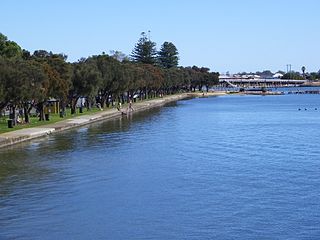Mandora Station is a cattle station on the Western Australia coast south of Broome, located in the Shire of Broome. In earlier years it has also been a sheep station. [1]

In Australia, a cattle station is a large farm, whose main activity is the rearing of cattle; the owner of a cattle station is called a grazier. The largest cattle station in the world is Anna Creek Station in South Australia, Australia.

Western Australia is a state occupying the entire western third of Australia. It is bounded by the Indian Ocean to the north and west, and the Southern Ocean to the south, the Northern Territory to the north-east, and South Australia to the south-east. Western Australia is Australia's largest state, with a total land area of 2,529,875 square kilometres, and the second-largest country subdivision in the world, surpassed only by Russia's Sakha Republic. The state has about 2.6 million inhabitants – around 11 percent of the national total – of whom the vast majority live in the south-west corner, 79 per cent of the population living in the Perth area, leaving the remainder of the state sparsely populated.

Broome is a coastal, pearling and tourist town in the Kimberley region of Western Australia, 2,240 km (1,390 mi) north of Perth. The urban population was 13,984 at the 2016 Census growing to over 45,000 per month during the peak tourist season.
Contents
It maintains a weather station and is noted for the Mandora Marsh wetland, and for its proximity to Eighty Mile Beach, which are key stopping places for migratory birds.

Mandora Marsh, also known as Mandora Salt Marsh, is a complex and diverse wetland system in Western Australia close to Eighty Mile Beach, and included in the Eighty Mile Beach Ramsar Site. It lies at the western edge of the Great Sandy Desert bioregion and within the Mandora Station pastoral lease. The marsh is part of the 3337 km2 Mandora Marsh and Anna Plains Important Bird Area, identified as such by BirdLife International because of its importance for supporting large numbers of waders and waterbirds.

Eighty Mile Beach, also spelled Eighty-mile Beach or 80-mile Beach, lies along the north-west coast of Western Australia about half-way between the towns of Broome and Port Hedland. It is a beach some 220 kilometres (140 mi) in length, forming the coastline where the Great Sandy Desert approaches the Indian Ocean. It is one of the most important sites for migratory shorebirds, or waders, in Australia, and is recognised as a wetland of international importance under the Ramsar Convention on Wetlands.

Bird migration is the regular seasonal movement, often north and south along a flyway, between breeding and wintering grounds. Many species of bird migrate. Migration carries high costs in predation and mortality, including from hunting by humans, and is driven primarily by availability of food. It occurs mainly in the northern hemisphere, where birds are funneled on to specific routes by natural barriers such as the Mediterranean Sea or the Caribbean Sea.
Mandora crater on Mars is named after the locality; the Mandurah suburb of Madora Bay was also derived from the station as well.

Mandora is a crater on Mars at 12.3N 53.7W. It is 59.4 km in diameter, and is named after the locality of Mandora in Western Australia.

Mars is the fourth planet from the Sun and the second-smallest planet in the Solar System after Mercury. In English, Mars carries a name of the Roman god of war, and is often referred to as the "Red Planet" because the iron oxide prevalent on its surface gives it a reddish appearance that is distinctive among the astronomical bodies visible to the naked eye. Mars is a terrestrial planet with a thin atmosphere, having surface features reminiscent both of the impact craters of the Moon and the valleys, deserts, and polar ice caps of Earth.

Mandurah is a coastal city in Western Australia, situated approximately 72 kilometres (45 mi) south of the state capital, Perth. It is the state's second-largest city, with a population just ahead of that of Bunbury.
In 2017 the property was sold by Peter and Pol Edmunds. The Edmunds are relatives of the De Pledge family who had owned the property since the 1940s. The 94,000-hectare (232,279-acre) property stocked with 4,500 head of droughtmaster cattle was bought by the Sale family who also have an interest in Bulka, Yougawalla, and Margaret River Stations. [2]

The Droughtmaster is a tropical breed of beef cattle developed in North Queensland, Australia by several cattlemen from crossing Brahman and British breed cattle, principally the Beef Shorthorn during the early 1900s.



